What is Conversion Rate Optimization (& What are the Benefits)?
Is your site as successful as it could be? Is your landing page or website performing at its peak—or are leads and sales slipping away? If your web pages aren’t meeting your objectives, you’re likely not focused on optimizing your conversion rate. Conversion rate optimization is the process of curating your page in a way that gets more people to take a specific action.
What is conversion rate optimization?
Conversion rate optimization is, in essence, the following 4-step process:
- Analyze current conversion by looking at all the variables that are influencing your CRO.
- Talk to your audience to understand why your visitors are leaving as opposed to converteding.
- Make changes and focus your efforts on improving things your audience provided feedback on.
- Continuously test your changes to determine what’s working (and what’s not).

It’s very common for a website to have multiple conversion goals, but a landing page should each have only one. Your homepage, for example, is tasked with presenting your brand, defining your value proposition, pointing visitors in the right direction, and presenting your most important call-to-action. While on a landing page, the focus is squarely and exclusively on a single goal, such as downloading a resource, purchasing a product, or registering for a webinar.
What’s a conversion?
Step one is to identify the single desired action that you want your customers to take, that’s your conversion event.
Conversion refers to that single, specific desired action: subscribe, register, buy-now, download, etc. You’re moving someone from one part of your funnel to the other: a visitor becomes a subscriber, or a subscriber becomes a customer.
Some common examples of conversion are:
- Purchasing a product
- Requesting a quote or consultation
- Subscribing to a paid service
- Subscribing to an email list or newsletter
- Creating an account, free or paid
- Adding a product to a cart
What’s a conversion rate?
The conversion rate refers to the number of people taking your desired action, compared to the total number of sessions (visits) to your page.
The easy way to figure out your conversion rate: divide the number of total conversions (actions taken) by the number of sessions (unique visits to the site).
For example, the goal of your blog is to get subscribers (which gets more people on your customer list). Your blog has 500 sessions with 100 new subscribers. That means you have a 20% conversion rate (100 conversions divided by 500 sessions).

So what is conversion rate optimization?
You’ve got the conversion: the action you want your visitor to take. You’ve got your current conversion rate: the actions taken divided by the unique visits. Now, you want to get a higher conversion rate, which means more people taking the desired action.
That’s what conversion rate optimization does. It pinpoints specific factors that can be improved, changed, or enhanced to get more people converting.
These factors can be as small the color of your CTA box from blue to orange, or as significant as completely repackaging the way you offer your services.
Why is conversion rate optimization important?
What are the benefits of optimizing your conversion rate?
Conversion rate optimization helps you:
- Minimize acquisition cost by making the most of your hard-won web traffic
- Grow your email list with qualified leads faster
- Increase your sales (and repeat sales)
- Help you better understand your audience’s expectations (and what compels them to act)
Better understand your audience’s expectations
To convert customers, you need to understand them: how they speak, what they want, and what problems they’re trying to solve. Going through the process of optimizing your web pages and campaigns is essentially the same as performing market research. But sometimes it’s even better because you’re asking ultra-specific questions about the sort of language, visuals, and message that best resonate with your customer.
To convert more visitors, you likely need to improve the way you’re engaging your visitor. This might mean you need to change the copy or design, offer a new lead magnet, or make the conversion process easier and more streamlined.
Conversion optimization is an opportunity to create a better user experience from start to finish. When the experience is better, the user is more likely to convert. If they convert, they’re engaging with your brand more. It becomes a positive cycle of conversion and growth.
Increase your ROI with conversion-rate optimization
Boosting your conversion rate automatically improves your KPIs (key metrics) without having to go out and find more customers. You’ll get more out of your acquisition costs by converting more of your traffic into subscribers and buyers.
Let’s say that you have a paid ad on Google that brings in about 1,000 viewers to your landing page every day. You want visitors to input their email for a free case study downloadable (this is your conversion action).
Your current conversion rate is 2%, meaning you get about 20 new email addresses daily. You’re paying for 1,000 clicks on your ad and receiving just 20 email addresses.
But what if you focused on boosting your conversion rate up to 5%? Now, of those 1,000 viewers, you’d get 50 new leads every day. That’s 210 new leads per week, 840 per month, and 10,080 per year. That’s 10,000 leads you’d get for the same paid ad, just by improving your conversion rate by 3 percentage points.
Focusing on conversion optimization is one of the most cost-effective ways to get the most value for your marketing efforts.
Collect more leads and sales
With traffic remaining the same, a higher conversion rate means more people are moving through your sales process. They’re subscribing to your newsletter, becoming members, and making purchases (or repeat purchases). These conversions are the lifeblood of your business. Collecting email addresses and making sales— that’s how your business stays in business.
Beyond that, having a conversion optimization system is critical as your business continues to scale. It helps you streamline the conversion process, so you’re not constantly chasing leads. Leads are steadily converting, and your conversion rate is steadily improving because you’ve already optimized the process.
Note:
This doesn’t mean you can just “set” your page to convert and then let it fly. Optimization is a constant process. It never stops. But as you know your audience better and do more tests, the easier and faster optimization will be.
Better user experience = better SEO
Search engines love optimized pages. If your page is optimized for conversion, that means it’s:
- User-friendly and easy to use/read
- Full of relevant info and content that speaks to your audience
- Attracting more click-throughs on your site
Google’s algorithm favors each of those factors. When someone is spending more time on your site, they’re taking actions on your site. And when your site is easy to use and chock full of good info, it signals to Google that your website is high quality and worthy of a high ranking.
Keep in mind, however, that search engine optimization is not the same as conversion optimization. The goal is to build in both features that are great for SEO and features that are great for conversion.
How would you design a website to optimize for conversions?
In chapter four of this guide (How Can I Improve Conversion Rate On My Page?) , we’ll go in-depth with specific tips and tricks that can bump up your page’s conversion optimization. For now, let’s give you the basics of how you can improve your conversion optimization on a macro level.
At its core, this is the conversion rate optimization process:
- Analyze current conversion by looking at all the variables that are influencing your CRO.
- Talk to your audience to understand why your visitors are leaving as opposed to converting.
- Make changes and focus your efforts on improving things your audience provided feedback on.
- Continuously test your changes to determine what’s working (and what’s not).

1. Track and measure what matters most
A conversion rate isn’t a standalone number. You want to look at all of the variables that could influence your conversion rate. Here are some metrics to keep track of:
- Where/how are people first entering your site? You want a visitor to land on a conversion-optimized webpage. For example, if your audience tends to find your blogs first, you want to make sure those blogs have a CTA to sign up for a newsletter or get upgraded content.
- Where is your traffic coming from? You want to emphasize those traffic avenues that bring in the largest amount of qualified prospects (people who would actually be interested in converting).
- Which pages and features do visitors most engage with? Try to understand where you’re already seeing the greatest (and the least) success on your site. Take note of similarities between the pages that currently convert the best.
- Which devices are they using to find you (mobile vs desktop)? This helps ensure you’re compatible and streamlining the opt-in or checkout process.
- What are your visitors’ demographics and interests? You want your visitors to look like your ideal customer. If the traffic coming in doesn’t match your customer audience, your conversion rate will suffer.
- At what point do users abandon your conversion funnel? Determine the moment when people are most likely to click away as opposed to make the conversion.
How do you find these metrics? Start by checking out Google Analytics. If you use Leadpages, we also have advanced tracking and analysis to help you understand where your conversion rate is coming from.
2. Ask your audience for qualitative feedback
You have the quantitative data, but now you need the insights and understandings behind the behavioral data. You want to know why some visitors are leaving as opposed to converting. For that, you’ll want to go right to the source.
Ask some of the following questions to get a better idea of how your visitor is interacting with the page:
- What about this page or offer appealed to you?
- Why did you decide to visit our site or page?
- How would you describe our offerings?
- Why did you choose not to opt-in/make the purchase?
Don’t ask questions that you already know the answer to through quantitative data, like “where were you directed from?” if you already know that traffic is coming through Google AdWords. You can look directly at your Adwords conversion rate to get this number, so don’t waste the question.
How do you get this information? User testing and satisfaction surveys are the simplest way. If a visitor is about to click away, you can have a survey pop up to ask them about their experience. If you notice a lead didn’t convert, you can send a follow-up email inquiring why.

Don’t be afraid to ask where you’re falling short of your customers’ expectations. More often than not, customers want to give you their input, so you can provide them with an improved experience in the future.
3. Answer their demands and make changes
You’ve got the data about what’s going wrong—now make the necessary changes. You’ve also got the data with what’s going right, so emphasize these areas.
For example, your metrics show that a lot of your visitors land on your blog content, but they leave right after reading your blog. The qualitative data from surveys say that these visitors like your content, but they didn’t notice any other way to engage with the brand.
You can conclude that your call to action (that asks visitors to subscribe to your blog) is too subtle. You might want to try placing more “subscribe” moments throughout the blog or redesigning the button to be bigger and bolder.
4. Run A/B tests and split tests
To transform an average conversion rate into an incredible one, you need to test and experiment. You won’t know how to boost your conversion rate until you make a change and try something new. Keep in mind, if the change doesn’t work, you can always switch it back.
Change one small variable at a time. You might swap the color of your CTA button or rewrite the headline or add in a picture of your product or offer. Make one change, and then see how it impacts your conversion rate. If your conversion goes up, stick with the new variable. If it’s not moving or goes down, it’s time to run a different test.
Learn about A/B testing in chapter five.

You don’t want to guess what your customer wants. That won’t get you anywhere. You want to consider the full picture of quantitative and qualitative data in order to run different tests.
Want to easily run AB tests and split tests without getting caught up in code?
Leadpages offers unlimited AB tests that you can set up in a matter of minutes.
Conversion rate optimization is a strategy
Conversion rate optimization is a process and a strategy. It’s about figuring out what your customers want and then designing content that will engage them and compel them to act.
We’ve given you the basic steps and benefits of conversion rate optimization and where to start. Now let’s really dig into it. Time to calculate your baseline conversion rate and define your goals, so you can take your pages to the next level.